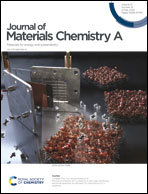Lead-free layered Aurivillius-type Sn-based halide perovskite Ba2X2[Csn−1SnnX3n+1] (X = I/Br/Cl) with an optimal band gap of ∼1.26 eV and theoretical efficiency beyond 27% for photovoltaics†
Abstract
Sn-based perovskite solar cells (PSCs) have shown great advantages as capable alternatives to poisonous Pb-based PSCs, with impressive certified power conversion efficiencies (PCE) beyond 14%. However, their poor stability induced by oxidation has hindered the further development of Sn-based PSCs. Herein, through first-principles calculations, inorganic layered Aurivillius-type Sn-based halide perovskites Ba2X2[Csn−1SnnX3n+1] (X = I/Br/Cl) have been designed, in which the [Ba2X2] layer blocks the oxygen in air, enhancing the inoxidizability of the crystals. Ba2X2[Csn−1SnnX3n+1] exhibit direct band gaps (0.84–2.20 eV), satisfying the requirements for single- and multi-junction PSCs. As the best candidate, Ba2Br2[Cs2Sn3Br10] has an optimal band gap (1.26 eV), high carrier mobility (135–173 cm2 V−1 s−1) and desirable absorption coefficient (∼105 cm−1). Consequently, the optimized single-junction SnO2/Ba2Br2[Cs2Sn3Br10]/CuSbS2 shows a record PCE of 27.7% among Sn-based PSCs, beyond the champion PCE of Pb-based PSCs (25.5%). These energetic results provide a new perspective to improve the performance of Sn-based single-junction PSCs and give a potential alternative to bottom/top PSCs in tandem devices.
![Graphical abstract: Lead-free layered Aurivillius-type Sn-based halide perovskite Ba2X2[Csn−1SnnX3n+1] (X = I/Br/Cl) with an optimal band gap of ∼1.26 eV and theoretical efficiency beyond 27% for photovoltaics](/en/Image/Get?imageInfo.ImageType=GA&imageInfo.ImageIdentifier.ManuscriptID=D1TA10822K&imageInfo.ImageIdentifier.Year=2022)


 Please wait while we load your content...
Please wait while we load your content...